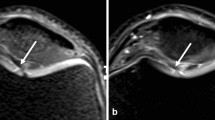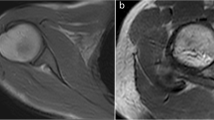Abstract
Purpose
4D-visualization of the human upper arm based on sequential or dynamic MRI may be useful in functional orthopedic disorders and surgical planning. A cascade of 4D-visualization approaches have been applied including deformation of the soft tissue surfaces and muscular contraction. Skeletal structures and the epifascial tissue comprising vascular structures are included in the 4D-visualization.
Methods
Sequential MRI (T2-weighted spin echo sequences) scans of a healthy volunteer’s upper extremity were obtained. The skeletal, muscular, and epifascial tissues were segmented. For 4D-rendering of the elbow joint, surface models of the humerus, the ulna, and the radius, were displaced with respect to the movement. For 4D-visualization of the soft tissue, the processed MRI data were subjected to highly transparent direct volume rendering with special two-tone transfer functions designed with regard to the application, e.g., muscular inner structure or fasciae. For rendering of time dependent behavior, the visualization was continuously updated.
Results
Continuous deformation of muscular inner structure and fasciae, and dynamics of muscle fibers could be differentiated in 4D-visualizations of the upper extremity. Using sequential MRI scans, this work was constrained by the high sagittal slice thickness and separation.
Conclusion
4D-visualization of the upper extremity based on sequential MRI is feasible and provides a realistic appearance in comparison with anatomical drawings and preparations. The 4D-visualization method may be useful for detecting and monitoring muscular pathologies and lesions.
Similar content being viewed by others
Abbreviations
- CT:
-
Computer tomography
- MRI:
-
Magnetic resonance imaging
- SE:
-
Spin echo
- TE:
-
Echo time
- TR:
-
Repetition time
References
Olsen NJ, Qi J, Park JH (2005) Imaging and skeletal muscle disease. Curr Rheumatol Rep 7(2): 106–114
Baumann F, Brühlmann P, Andreisek G, Michel BA, Marincek B, Weishaupt D (2005) MRI for diagnosis and monitoring of patients with eosinophilic fasciitis. Am J Roentgenol 184(1): 169–174
Gilles B, Magnenat-Thalmann N (2010) Musculoskeletal MRI segmentation using multi-resolution simplex meshes with medial representations. Med Image Anal 14(3): 291–302
Zhong X, Epstein FH, Spottiswoode BS, Helm PA, Blemker SS (2008) Imaging two-dimensional displacements and strains in skeletal muscle during joint motion by cine DENSE MR. J Biomech 41(3): 532–540
Magnenat-Thalmann N (2010) “3DAnatomicalHuman” EU Marie Curie Research Training Network, MIRALab, University of Geneva, Switzerland. http://3dah.miralab.ch/. Accessed 15 August 2010
Kober C, Berg BI, Sturmat M, Rieger J, Gallo L, Boel M, Mack M, Zeilhofer HF, Sader R (2010) Macroscopic muscular modeling based on in vivo 4D-radiology. In: Boel M, Kuhl E (eds) Active tissue modeling—from single muscle cells to muscular contraction. Int J Multiscale Eng (accepted for publication)
Bi X, Weale P, Schmitt P, Zuehlsdorff S, Jerecic R (2010) Non-contrast-enhanced four-dimensional (4D) intracranial MR angiography: a feasibility study. Magn Reson Med 63(3): 835–841
Visage Imaging GmbH (2010) Amira—visualize, analyze, present. http://www.amira.com/. Accessed 13 May 2010
Stalling D, Westerhoff M, Hege HC (2005) Amira. A highly interactive system for visual data analysis. In: Hansen CD, Johnson CR (eds) The visualization handbook. Elsevier, Amsterdam, pp 749–767
Gray H (1918) Anatomy of the human body. Lea & Febiger, New York
Putz R, Pabst R (1997) Sobotta, Atlas der Anatomie des Menschen. Elsevier GmbH, Urban & Fischer Verlag München
Rohen JW, Yokochi C, Lütjen-Drecoll E (2006) Anatomie des Menschen—Fotgraphischer Atlas der systematischen und topografischen Anatomie. Schattauer, Stuttgart
Magnenat-Thalmann N, Charbonnier C, Schmid J (2008) Multimedia application to the simulation of human musculoskeletal system: a visual lower limb model from multimodal captured data. In: Proceedings of IEEE international workshop multimedia signal processing, Cairns, Australia, pp 520–525
Agus M, Giachetti A, Gobbetti E, Guitián JAI, Marton F (2008) Towards advanced volumetric display of the human musculoskeletal system. In: Scarano V, De Chiara R, Erra U (eds) Eurographics Italian Chapter Conference. Eurographics Association. http://www.eg.org/. Accessed 15 August 2010
Sturmat M, Kober C, Boel M (2010) Experimental and numerical investigations in skeletal muscle modeling. Submitted to PAMM
Author information
Authors and Affiliations
Corresponding author
Electronic Supplementary Material
The Below is the Electronic Supplementary Material.
Rights and permissions
About this article
Cite this article
Kober, C., Gallo, L., Zeilhofer, HF. et al. Computer-assisted analysis of human upper arm flexion by 4D-visualization based on MRI. Int J CARS 6, 675–684 (2011). https://doi.org/10.1007/s11548-011-0546-8
Received:
Accepted:
Published:
Issue Date:
DOI: https://doi.org/10.1007/s11548-011-0546-8




